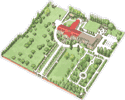Original Building: 1871 Wing
In 1871, the same year that British Columbia became a Canadian province, construction began on the first wing of the Academy, as it appears today. The design for the building was by Joseph Michaud, C.S.V., and was executed by Charles Vereydhen, an architect born in Belgium. Vereydhen arrived to establish an architectural practice in Victoria in 1858 and was one of only four architects listed in the Victoria Directory at the time.
The cornerstone of this structure, the first four-storey masonry building in Victoria, was laid amongst a large group of church, city and provincial dignitaries, including Sir James Douglas and the Lieutenant Governor J.W. Trutch. As Governor Trutch spoke about the little school on Humboldt Street, he stated that the construction of learning institutions was "indeed amongst the highest duties of every Christian people, and especially of a community like ours, in its infancy. And ... it is impossible to overrate the benefits conferred by the Sisters of Saint Ann ... I rejoice that the prospects of the considerable extension of their good work has made it necessary to provide increased accommodation." (The British Colonist, September 13, 1871)

Although the 'New School' appears today as the wing between the Interpretative Centre and the Hooper Wing of 1910, it was originally a complete building. The main entrance to the original building was situated on the second floor, where a two-sided staircase converged into one set of stairs, that led up to the door. Based on modern testing of the paint layers, the building was made out of red brick, which was painted a pale, golden cream colour.
Until the next addition was made in 1886, this building housed the school, and a small residence, as most of the Sisters were then living at the View Street location. It also acted as the regional headquarters for the Sisters of Saint Ann, in the west. A small chapel was situated within this wing, later replaced by the main chapel. When this original school became the western wing of the Academy, its uses were focused on classrooms and teaching.
Dining Hall
After the 1886 construction, the main floor of the 1871 building contained the boarders' dining room and the pupils' scullery. After prayer, meals were eaten at tables with carefully set places for small groups of girls. The solemn air was enhanced by a large statue of the Virgin Mary, in a niche at the end of the room.
The girls were expected to clean up after they were finished eating. In the adjacent scullery, tea towels were rinsed and hung to dry after use, on long dowels that pulled out from behind the stove. The girls that were swimmers would often hang their bathing suits to dry in this warm spot after a weekend visit to the nearby pool at Crystal Gardens.
 The Cook, Sam Lee
The Cook, Sam Lee with his family
The food was simple, but healthful. In addition to the fruits and vegetables they could raise themselves, there were often gifts of produce from parents of students. Farms on the island provided milk, eggs and chicken. The snacks for after school included muffins and cookies. The Sisters were in charge of most of the baking, but for many years, cooks were hired for the main meals. Sam Lee was the cook at the Academy for 20 years, between 1902 and 1922. He lived with his family in a small house nearby, and his importance to the community at St. Ann's is recognized by two formal photographs, carefully preserved in the archives.
There were many challenges for cooks attempting to feed that many people. During the war, a gift of a barrel of salted herring was given to the Convent. Appreciative of the donation, the Sisters and their staff came up with ways to serve those fish: creamed, on toast, in paste ... they never forgot those herring.
The atmosphere in the dining hall was not as formal outside of meal times. For a number of years, a piano sat in this basement room, and the girls would go downstairs during their recreation time to try the latest dances. The tables made way for the Charleston, as one girl played the music and the others learned the steps.

